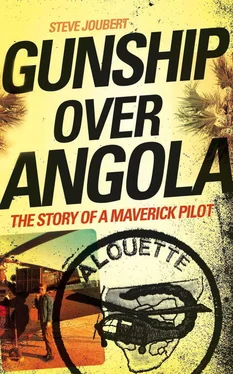At around 14h00 Neil and I were in the operations room at the Elundu base listening to events unfold on the radio when the patrol walked into the ambush and bullets, mortars and RPG-7s started to fly. As we ran out of the operations room, Neil, being taller than me, ran straight into a piece of angle iron that framed the exit from the underground structure. The impact opened a large wound on his forehead that required immediate attention from the base doctor, so I was forced to proceed to the contact scene on my own and he’d follow as soon as he could.
When I arrived, I had a clear view of our soldiers pinned down on the ground while mortars exploded among them. One fellow had been shot dead in the initial fusillade from the enemy and another had been shot in the stomach. All of them had dug holes into the soft sand with their hands and were trying to be as unobtrusive as humanly possible.
As normal, the arrival of a gunship overhead caused enemy fire to cease immediately. With the patrol commander giving me information over the radio about the direction from which the attack had come and my visual assessment, I knew that it was unlikely that the aggressors had departed the scene. So, while attempting to ignite the dense dry bush around the enemy positions with HE rounds from the 20 mm, which sometimes work like incendiaries, I kept telling the friendlies on the ground to remain in their positions until the all clear could be sounded.
I don’t know how long I orbited the scene, fruitlessly searching for movement or visual anomalies that would reveal the positions of the PLAN soldiers. Then, out of the corner of my eye, I saw a movement among the pinned-down patrol as one of them stood up to go to the aid of the wounded man. The would-be rescuer was immediately shot dead by an enemy sniper.
‘For fuck’s sakes, stay down until I give the all clear!’ I screamed over the radio at the patrol, frustration and helplessness threatening to overwhelm me.
The exasperation grew exponentially as I searched each square metre of the surrounding bush, in vain, for the hidden enemy troops.
There was no more firing after that one shot. When Neil arrived, head stitched up, we were finally able to declare the scene safe and get help to those who needed it. For the next couple of hours, we took turns to move our own patrols into the area to cut off the escape routes of the PLAN soldiers involved in the earlier ambush.
The shadows were already quite long, and I estimate that it was around 17h00, when I looked down and saw a group of around 30 uniformed soldiers walking through the bush. They were looking up at me as I circled them. None of our patrols was supposed to be where these guys were, and there was something unusual about the way they looked or the way they were walking – I couldn’t put my finger on it.
I made a number of radio calls asking for the patrol below me to please identify themselves. Nothing. Not a peep. Then I asked that all the patrols in the area, seven or eight in total, make sure that their members were present and accounted for. They all confirmed that they were and that none were below my circling chopper.
Still unsure, and obviously completely unwilling to attack my own troops with a 20 mm cannon, I decided to take a closer look and descended to a height of around 150 metres.
Suddenly, from the edge of the group walking below me, I saw a man go down on one knee and point something up at my gunship. This was followed by a flash as the RPG-7 he was holding was fired. Then all hell broke loose. My abiding memory is of the curved magazines of the AK-47s as everyone opened fire on my poor little helicopter.
The 20 mm immediately began its staccato beat as my flight engineer opened up with repeated two-to-three-shot bursts at the rapidly dispersing enemy below. I saw a number of them struck and fall to the ground. Then the 20 mm jammed. By the time the flight engineer had cleared the obstruction, the balance of the enemy force had disappeared.
From the firing of the RPG at my gunship to the jamming of our 20 mm perhaps 20 to 30 seconds had elapsed. Although it was late in the day to do so, I called in some Pumas that had just arrived to drop reaction-force stopper groups on the ground, in an attempt to box the enemy in.
No more than a few minutes after my blazing encounter with the PLAN group, one of the Pumas passed below me, travelling from my 5 o’clock to 11 o’clock. From behind and directly underneath me there suddenly appeared a bright red dot trailing black smoke, the undeniable signature of another RPG-7 projectile, which was chasing the departing Puma and rapidly gaining on it.
At the last possible moment, the Puma seemed quickly to lift its tail boom, like a girl raising her long skirts when jumping over a spider on the ground. The lethal chunk of Russian widowmaker missed it by only a few inches.
As it did so, I heard the pilot of the Puma shout, ‘Yikes! That was close.’
*
My final encounter with this unusual group of PLAN soldiers was a few days later when they ambushed a convoy of supply vehicles on Fernando’s Road between Oshigambo and Eenhana. The convoy protection detail consisted of some young national servicemen who’d been in the bush only a few days.
Again, our gunship formation just happened to be in the vicinity and we arrived overhead quite quickly, within ten minutes or so of the attack. We were confronted with utter carnage and indescribable terror on the part of the survivors. I recall that it took quite a while to calm a young man who was screaming hysterically into the handset of the ground-to-air radio, which was still attached to his friend, a 17-year-old boy who’d been fatally wounded in the opening salvo of the attack.
Although the panic-stricken infantrymen had attempted to drive out of the ambush when they realised what was happening, this frantic course of action unknowingly compromised their convoy’s defensive integrity, as all the vehicles were so comprehensively shot up by the well-organised attackers that they managed only to get a short distance down the road before breaking down, each quite a way from the next, halting any further escape.
Some months later I was in a pub at the Army Battle School in Lohatla when a young national service officer approached me, having somehow recognised me, and offered to buy me a drink. He told me that he’d been involved in the ambush, and that his abject terror had been born of the very real prospect that the enemy would overrun the almost defenceless disabled vehicles and slaughter all the survivors. The fortuitous arrival of our two gunships, however, scuppered the PLAN objectives, and the attackers had dispersed into the bush. The young officer told me that the ‘whop-whopping’ of the rotors and the noise of the engines as the two Alos arrived overhead was the sweetest sound he’d ever heard. It was only then that his fear had started to abate.
He was 19 years old at the time.
*
In April 1981, an operation was planned to hit a PLAN base just east of Xangongo (formerly Vila Roçadas), and I was one of the chopper pilots chosen to participate. The operation started unremarkably with two gunships flown by Paul Dore and Paul Downer (nicknamed ‘the two Pauls’) flying to Cuamato, a hamlet around 60 kilometres inside Angola.
When not occupied by invading SADF forces, Cuamato was usually the base for a small contingent of FAPLA troops. Once overhead, the two Pauls fired short bursts from their 20 mm cannons into the middle of the main street. This had become relatively standard practice (never a good thing in war) and had previously always led to the FAPLA soldiers stationed there immediately vacating the village and heading for safety some distance to the north.
When the FAPLA soldiers were clear of the area, Puma helicopters would bring in a large force of SADF men and equipment to set up the ops headquarters and the rest of the Alos would land there too. The force would then invariably be joined by the armoured contingent, who had driven off-road to Cuamato in their Ratels and Elands from inside Ovamboland.
Читать дальше












